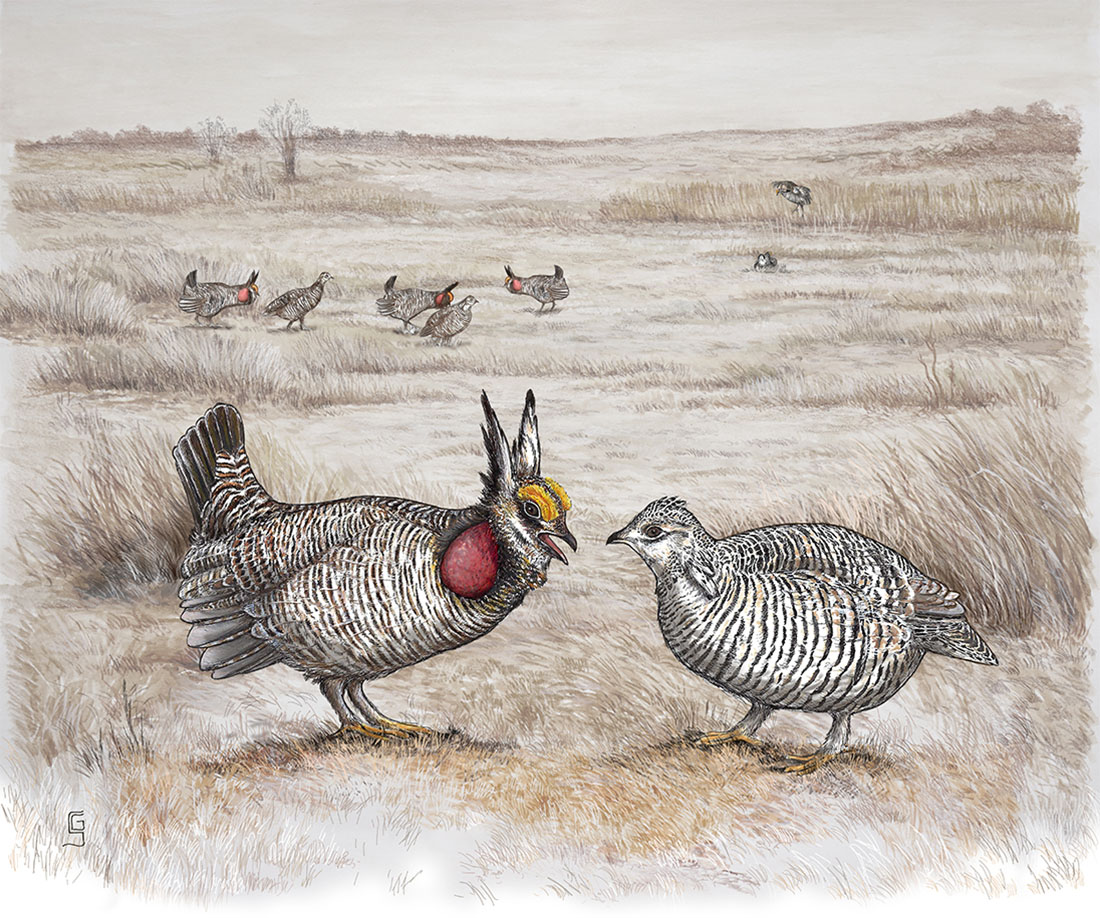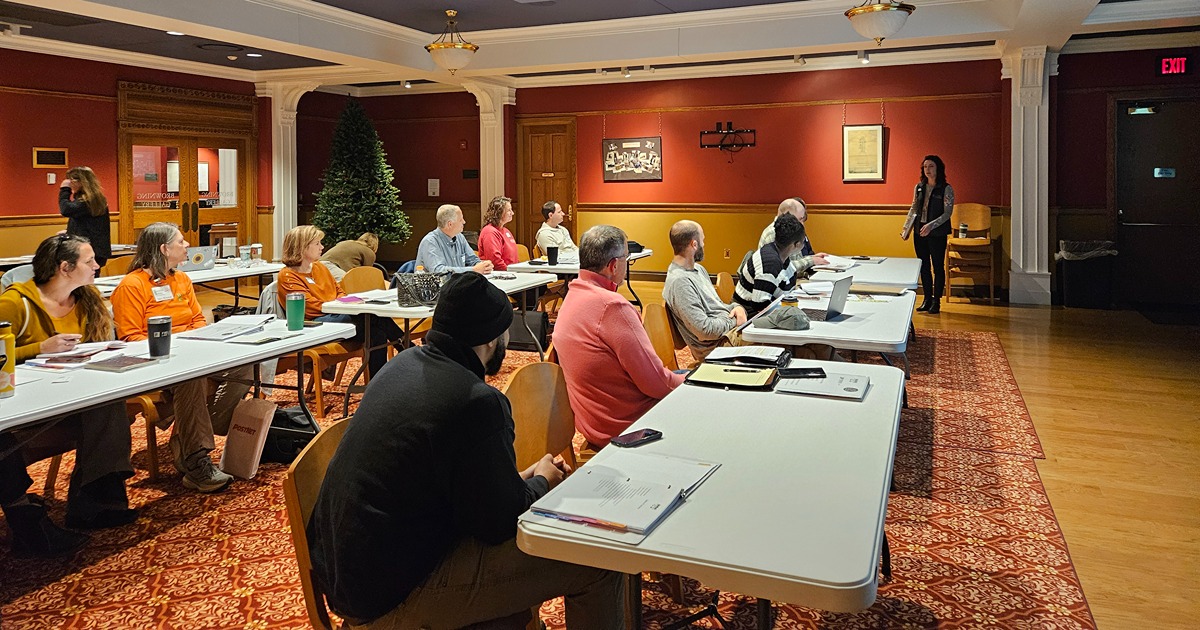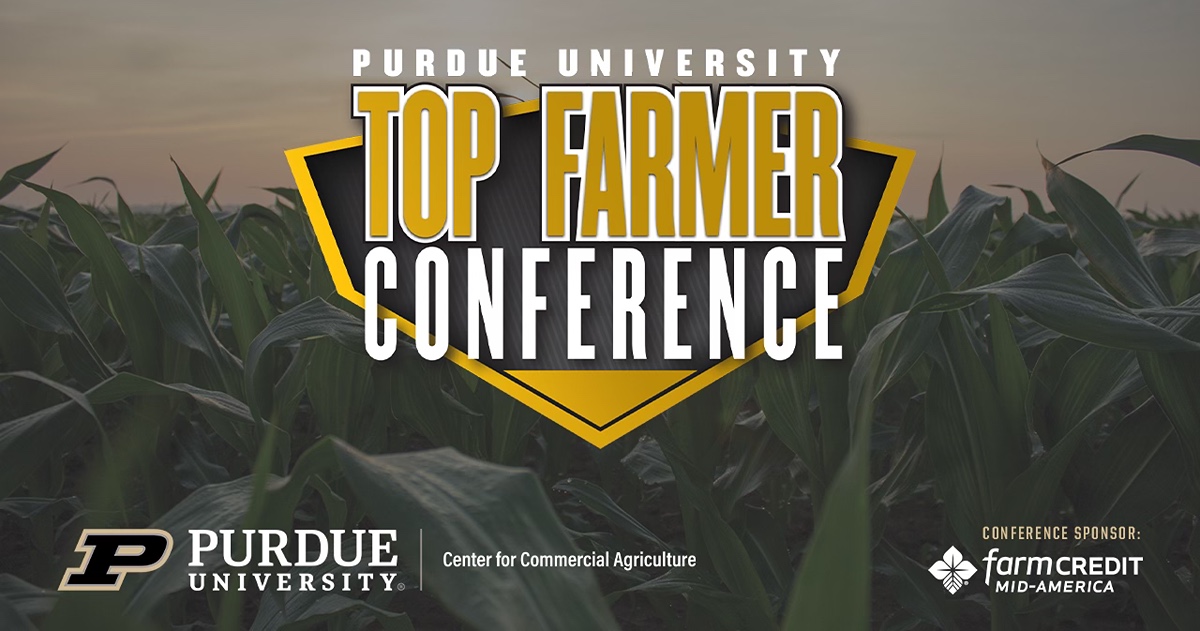Genomic analyses of prairie chickens cast doubt on species classifications
Impact of sampling from five states could affect wildlife management nationwide
Biologists originally classified the lesser and greater prairie chickens of the Great Plains as two different species. Difficult to distinguish by their physical appearance alone, some scientists have wondered for decades if these grouse consist of only one species.
An accurate understanding of prairie chicken speciation gained new urgency in 2022, when the U.S. Fish and Wildlife Service listed the lesser prairie chicken as endangered in the southern portion of its range.
Now, a rigorous genomics study of prairie chickens in Colorado, Kansas, Oklahoma, New Mexico and Texas led by Purdue University scientists has found evidence of hybridization between species with no clear indication of genetic problems such as inbreeding. The scientists published their findings July 24, 2024, in the Proceedings of the National Academy of Sciences Nexus.
Using technology that study co-author Zachary Lowe likens to “GPS for genetics,” the results show the power of genomics to document which animals are a mix of closely related species and which ones genetically qualify as unique lineages.
“With this type of genetic work, we are more informed and more able to get to where we’re going accurately and quickly because this is the best available science,” said Lowe, a Purdue adjunct faculty member and executive director of the Western Association of Fish and Wildlife Agencies. “When we rely on the best available science, we are more likely to make the best decision and to get the best outcome.”
The Endangered Species Act of 1973 provides no clear guidelines about how to address hybrids between two presumptive species that breed with one another. That presents challenges to wildlife managers whose lands include hybrid animals, said study co-author Andrew Black, a former Purdue postdoctoral scientist now at Oregon State University.
The two species began diverging between 600,000 and 900,000 years ago — a short time by biological standards. “These species will breed easily together, so it’s important to take a study like this and figure out the best way to manage and protect the remaining diversity that we see,” Black said.
 Artist rendering of lesser prairie chickens. Male (left) and female in a prairie setting. Biologists originally classified lesser and greater prairie chickens as two species. New research indicates they may belong to the same species. (Purdue University/Gabriela Sincich)
Artist rendering of lesser prairie chickens. Male (left) and female in a prairie setting. Biologists originally classified lesser and greater prairie chickens as two species. New research indicates they may belong to the same species. (Purdue University/Gabriela Sincich)
The preexisting data came from 433 greater and lesser prairie chickens, mostly the latter, spanning 10 years and collected by researchers in Colorado, Kansas, Oklahoma, New Mexico and Texas. The research team sequenced the entire genome of each bird an average of four times. Each genome consisted of about a billion nucleotides, the small molecules that make larger DNA molecules. The team needed supercomputers at Purdue’s Rosen Center for Advanced Computing and the Pittsburgh Supercomputing Center to process more than a trillion nucleotides of data.
“This is a massive dataset that allows us to assess the genetic health of these populations across the range and to evaluate gene flow between the lesser and greater prairie chicken species,” Black said. The data revealed little cause for concern with respect to genetic diversity. “Of course, these things can change quickly if they have population declines or disease outbreaks,” he cautioned.
Although the study analyzed the genetics of prairie chickens in five states, the methods are relevant to the nationwide jurisdictional management of endangered and threatened species. When a species becomes formally listed, management passes from the relevant states to the federal government. Such jurisdictional changes can impact the agricultural and natural resources industries operating in the affected local economies.
Senior author J. Andrew DeWoody, professor of genetics in Purdue’s Department of Forestry and Natural Resources, and Black published a similar study earlier this year regarding an endangered species of pupfish in New Mexico. The genomics data from that study indicated what had previously appeared to be one species was actually two.
 J. Andrew DeWoody, professor of genetics in Purdue’s Department of Forestry and Natural Resources, used supercomputers at Purdue’s Rosen Center for Advanced Computing and other locations, to sequence the genomes of 433 greater and lesser prairie chickens to understand hybridization between species.
Credit: Purdue Agricultural Communications/Joshua Clark
J. Andrew DeWoody, professor of genetics in Purdue’s Department of Forestry and Natural Resources, used supercomputers at Purdue’s Rosen Center for Advanced Computing and other locations, to sequence the genomes of 433 greater and lesser prairie chickens to understand hybridization between species.
Credit: Purdue Agricultural Communications/Joshua Clark
“This is a tool that will be implemented more and more in conservation,” Lowe predicted.
The Fish and Wildlife Service listing designated two distinct populations of lesser prairie chickens — northern and southern. Species labels aside, the main genetic differences — which were quite small — were between the northern and southern populations.
The genomics data identify the southern population, recently listed as endangered and consisting entirely of lesser prairie chickens, as distinct from the northern population. The northern population comprises a mix of lesser and greater prairie chickens.
“A distinct population segment doesn’t necessarily make it a different species. It just means separation by geography,” Lowe said.
The problem facing prairie chickens is one of habitat fragmentation rather than genetics. Fragmentation results from land-use changes such as converting short native prairie to row crop agriculture and human development. Even the seemingly low-impact change of placing wind farms in high-quality prairie chicken habitat will affect their behavior.
“They will just quit using that habitat because they avoid tall structures,” Lowe said. “The vast majority of the prairie chickens depend on privately owned agricultural working lands. This speaks to the importance of practical wildlife conservation efforts that support sustainable grasslands, cattle production and private landowner incentives.”
This research was funded by the Western Association of Fish and Wildlife Agencies.
About Purdue Agriculture
Purdue University’s College of Agriculture is one of the world’s leading colleges of agricultural, food, life and natural resource sciences. The college is committed to preparing students to make a difference in whatever careers they pursue; stretching the frontiers of science to discover solutions to some of our most pressing global, regional and local challenges; and, through Purdue Extension and other engagement programs, educating the people of Indiana, the nation and the world to improve their lives and livelihoods. To learn more about Purdue Agriculture, visit this site.
About Purdue University
Purdue University is a public research university leading with excellence at scale. Ranked among top 10 public universities in the United States, Purdue discovers, disseminates and deploys knowledge with a quality and at a scale second to none. More than 106,000 students study at Purdue across multiple campuses, locations and modalities, including more than 57,000 at our main campus locations in West Lafayette and Indianapolis. Committed to affordability and accessibility, Purdue’s main campus has frozen tuition 14 years in a row. See how Purdue never stops in the persistent pursuit of the next giant leap — including its integrated, comprehensive Indianapolis urban expansion; the Mitch Daniels School of Business; Purdue Computes; and the One Health initiative — at https://www.purdue.edu/president/strategic-initiatives.
Writer: Steve Koppes
Media contact: Devyn Ashlea Raver, draver@purdue.edu
Sources: Andrew DeWoody, dewoody@purdue.edu; Andrew Black, blackan@purdue.edu; Zach Lowe, zach.lowe@wafwa.org
Agricultural Communications: Maureen Manier, mmanier@purdue.edu, 765-494-8415
Journalist Assets: Images and/or Videos, Google Drive





